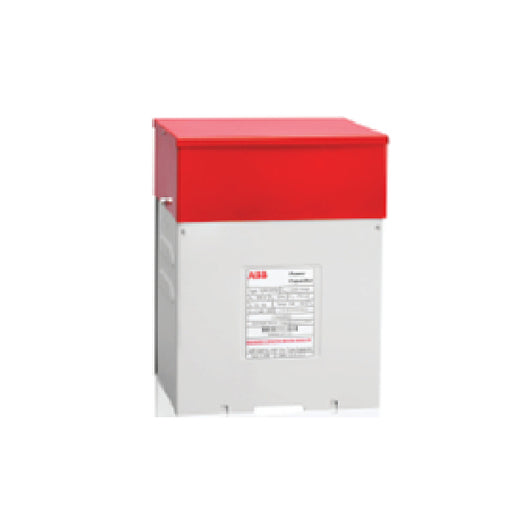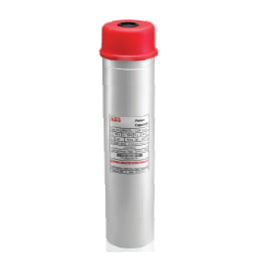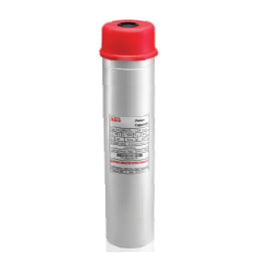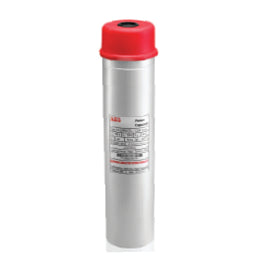Capacitors
-
ABB LV Capacitor BOX ND F5 V440 5 kvar
ABB LV Capacitor BOX ND F5 V440 5 kvar
Original price ₹0 - Original price ₹0Original price ₹0₹0₹0 - ₹0Current price ₹0| /Request for Quote -
ABB LV Capacitor BOX ND F5 V440 10 kvar
ABB LV Capacitor BOX ND F5 V440 10 kvar
Original price ₹0 - Original price ₹0Original price ₹0₹0₹0 - ₹0Current price ₹0| /Request for Quote -
ABB LV Capacitor CYL ND F5 V440 4.2 kvar
ABB LV Capacitor CYL ND F5 V440 4.2 kvar
Original price ₹0 - Original price ₹0Original price ₹0₹0₹0 - ₹0Current price ₹0| /Request for Quote -
ABB LV Capacitor BOX ND F5 V440 15 kvar
ABB LV Capacitor BOX ND F5 V440 15 kvar
Original price ₹0 - Original price ₹0Original price ₹0₹0₹0 - ₹0Current price ₹0| /Request for Quote -
ABB LV Capacitor BOX HD F5 V440 1 kvar
ABB LV Capacitor BOX HD F5 V440 1 kvar
Original price ₹0 - Original price ₹0Original price ₹0₹0₹0 - ₹0Current price ₹0| /Request for Quote -
ABB LV Capacitor CYL ND F5 V440 7.5 kvar
ABB LV Capacitor CYL ND F5 V440 7.5 kvar
Original price ₹0 - Original price ₹0Original price ₹0₹0₹0 - ₹0Current price ₹0| /Request for Quote -
ABB LV Capacitor CYL ND F5 V440 10 kvar
ABB LV Capacitor CYL ND F5 V440 10 kvar
Original price ₹0 - Original price ₹0Original price ₹0₹0₹0 - ₹0Current price ₹0| /Request for Quote -
ABB LV Capacitor CYL HD F5 V440 5 kvar
ABB LV Capacitor CYL HD F5 V440 5 kvar
Original price ₹0 - Original price ₹0Original price ₹0₹0₹0 - ₹0Current price ₹0| /Request for Quote -
ABB LV Capacitor CYL ND F5 V440 3 kvar
ABB LV Capacitor CYL ND F5 V440 3 kvar
Original price ₹0 - Original price ₹0Original price ₹0₹0₹0 - ₹0Current price ₹0| /Request for Quote -
ABB APP Type HD 10 Kvar 440 V 1HYC420000-019, Vashi Integrated Solutions,
Buy ABB APP Type HD 10 Kvar 440????V 1HYC420000-019, Online At The Best Prices From???? Vashi Integrated Solutions, Dealer And Distributor In India
Original price ₹0 - Original price ₹0Original price ₹0₹0₹0 - ₹0Current price ₹0| /Request for Quote -
ABB LV Capacitor BOX HD F5 V440 15 kvar
ABB LV Capacitor BOX HD F5 V440 15 kvar
Original price ₹0 - Original price ₹0Original price ₹0₹0₹0 - ₹0Current price ₹0| /Request for Quote -
ABB LV Capacitor BOX HD F5 V440 5 kvar
ABB LV Capacitor BOX HD F5 V440 5 kvar
Original price ₹0 - Original price ₹0Original price ₹0₹0₹0 - ₹0Current price ₹0| /Request for Quote -
ABB LV CAPACITORS - 1HYC414007-111
ABB LV CAPACITORS - 1HYC414007-111
Original price ₹0 - Original price ₹0Original price ₹0₹0₹0 - ₹0Current price ₹0| /Request for Quote -
ABB LV Capacitor CYL HD F5 V480 22.1 kvar
ABB LV Capacitor CYL HD F5 V480 22.1 kvar
Original price ₹0 - Original price ₹0Original price ₹0₹0₹0 - ₹0Current price ₹0| /Request for Quote -
ABB LV Capacitor CYL HD F5 V480 12.5 kvar
ABB LV Capacitor CYL HD F5 V480 12.5 kvar
Original price ₹0 - Original price ₹0Original price ₹0₹0₹0 - ₹0Current price ₹0| /Request for Quote -
ABB LV Capacitor CYL HD F5 V480 31.5 kvar
ABB LV Capacitor CYL HD F5 V480 31.5 kvar
Original price ₹0 - Original price ₹0Original price ₹0₹0₹0 - ₹0Current price ₹0| /Request for Quote -
ABB LV Capacitor CYL HD F5 V480 11.1 kvar
ABB LV Capacitor CYL HD F5 V480 11.1 kvar
Original price ₹0 - Original price ₹0Original price ₹0₹0₹0 - ₹0Current price ₹0| /Request for Quote -
ABB LV Capacitor CYL HD F5 V525 15.4 kvar
ABB LV Capacitor CYL HD F5 V525 15.4 kvar
Original price ₹0 - Original price ₹0Original price ₹0₹0₹0 - ₹0Current price ₹0| /Request for Quote -
ABB LV Capacitor CYL HD F5 V480 27.7 kvar
ABB LV Capacitor CYL HD F5 V480 27.7 kvar
Original price ₹0 - Original price ₹0Original price ₹0₹0₹0 - ₹0Current price ₹0| /Request for Quote -
ABB LV Capacitor CYL HD F5 V480 16.6 kvar
ABB LV Capacitor CYL HD F5 V480 16.6 kvar
Original price ₹0 - Original price ₹0Original price ₹0₹0₹0 - ₹0Current price ₹0| /Request for Quote -
ABB LV Capacitor CYL HD F5 V525 33.1 kvar
ABB LV Capacitor CYL HD F5 V525 33.1 kvar
Original price ₹0 - Original price ₹0Original price ₹0₹0₹0 - ₹0Current price ₹0| /Request for Quote -
ABB LV Capacitor CYL HD F5 V480 13.8 kvar
ABB LV Capacitor CYL HD F5 V480 13.8 kvar
Original price ₹0 - Original price ₹0Original price ₹0₹0₹0 - ₹0Current price ₹0| /Request for Quote -
ABB LV Capacitor CYL HD F5 V440 12.5 kvar
ABB LV Capacitor CYL HD F5 V440 12.5 kvar
Original price ₹0 - Original price ₹0Original price₹0₹0 - ₹0Current price ₹0| /Request for Quote -
ABB LV Capacitor CYL ND F5 V525 33.1 kvar
ABB LV Capacitor CYL ND F5 V525 33.1 kvar
Original price ₹0 - Original price ₹0Original price ₹0₹0₹0 - ₹0Current price ₹0| /Request for Quote
Buy Electronic Capacitors Online
A capacitor is an electronic component that stores electrical energy in an electric field. It consists of two conductive plates separated by an insulating material called a dielectric. The plates can be made of metal, and the dielectric can be a variety of materials such as ceramic, plastic, or electrolyte.
The basic function of a capacitor is to store and release electrical energy. When a voltage difference exists between the plates of the capacitor, an electric field is created across the dielectric, and electric charge is stored on the plates. The amount of charge that a capacitor can store is directly proportional to the voltage applied.
Application Of Capacitors
-
Energy storage: Capacitors store energy and can release it rapidly when needed. They are often used in conjunction with other components to filter and stabilize power supplies.
-
Timing circuits: Capacitors, in combination with resistors, can be used to create time delays and control the timing of signals in electronic circuits.
-
Coupling and decoupling: Capacitors allow AC (alternating current) signals to pass through while blocking DC (direct current). This property is used for coupling and decoupling AC and DC components in electronic circuits.
-
Signal filtering: Capacitors can be used to filter out certain frequencies in electronic signals, allowing only specific frequency components to pass through.
-
Tuning circuits: Capacitors are used in radio frequency circuits for tuning purposes, adjusting the resonance frequency of the circuit.
Capacitors come in various types, including electrolytic capacitors, ceramic capacitors, tantalum capacitors, and others. Each type has its own characteristics, and the choice of capacitor depends on the specific requirements of the circuit.
It's important to note that capacitors have polarity in the case of electrolytic capacitors, meaning that there is a correct orientation for connecting them in a circuit. Connecting a capacitor with reverse polarity can lead to damage or failure. Non-polarized capacitors, like ceramic capacitors, can be connected in either direction.
Frequently Asked Questions
Q1. What are capacitors uses for?
Ans. Capacitors are electronic components used to store and release electrical energy in various applications, such as power supplies, motors, timing circuits, and signal conditioning.
Q2. What are the different capacitor types?
Ans. Capacitors come in various types, including ceramic, electrolytic, tantalum, film, and supercapacitors, each with its own characteristics and suitable applications.
Q3. What is the capacitor unit of capacitance?
Ans. The unit of capacitance is the farad (F). Microfarads (μF) and picofarads (pF) are commonly used for smaller values in electronic applications.





























